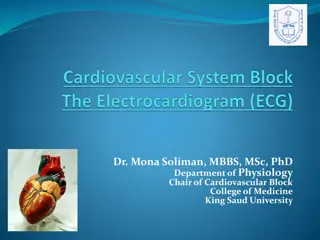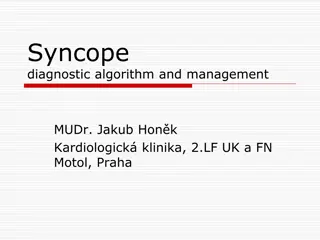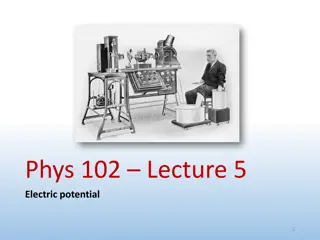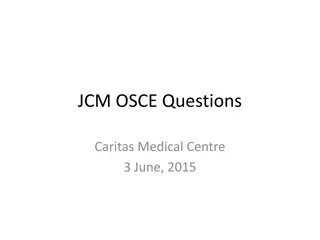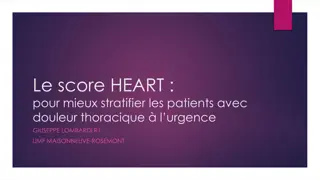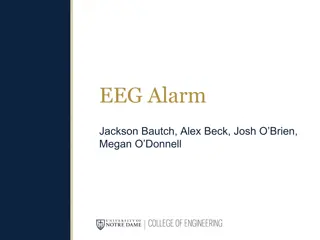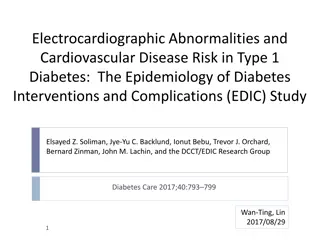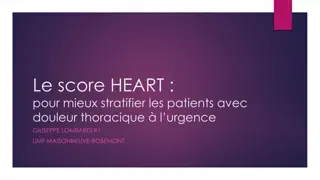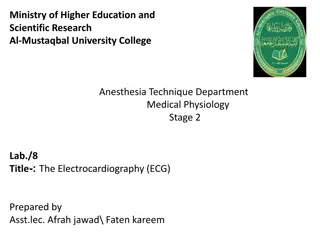Understanding ECG: Basics and Beyond
Explore the fundamentals of ECG interpretation, including cardiac conduction system, heart rate calculation methods, and characteristics of normal sinus rhythm. Gain insights on treating the patient based on ECG findings and understanding the correlation between electrical and mechanical activity in the heart. Dive into the anatomy of ECG waves and learn about the Rule of 300 for heart rate estimation.
Download Presentation

Please find below an Image/Link to download the presentation.
The content on the website is provided AS IS for your information and personal use only. It may not be sold, licensed, or shared on other websites without obtaining consent from the author. Download presentation by click this link. If you encounter any issues during the download, it is possible that the publisher has removed the file from their server.
E N D
Presentation Transcript
ECG The Basics And Beyond ANITA RALSTIN MS, FNP-BC
Pearls Treat the patient not the paper. Electrical activity triggers mechanical activity. No electrical activity = no mechanical activity But electrical activity does not guarantee mechanical activity. The more cells involved the larger the deflection on the ECG. If the wave of electrical activity is moving toward the electrode, the wave will be positive (above the baseline); if the wave is moving away from the electrode the wave will be negative (below the baseline).
Cardiac Conduction System NORMAL ECG One small box = .04 seconds One large box = .20 seconds Conduction picture courtesy of New Mexico Heart Institute
Anatomy and the ECG The P wave = atrial activation (SA node to AV node). The PR interval = onset of atrial activation to onset of ventricular activation. The QRS complex = electrical ventricular activation. The ST-T segment = ventricular repolarization. The QT interval = the duration of ventricular activation and recovery.
Calculation Of Heart Rate Method 1: Count the number of large (0.2- second) time boxes between two successive R waves, and divide the constant 300 by this number OR divide the constant 1500 by the number of small (0.04-second) time boxes between two successive R waves. Method 2 best for irregular rhythms: Count the number of cardiac cycles that occur every 6 seconds, and multiply this number by 10.
The Rule Of 300 It may be easiest to memorize the following table: # of big boxes 1 Rate 300 2 150 3 100 4 75 5 60 6 50
Question Calculate the heart rate
Definition of Normal Sinus Rhythm Heart rate 60-100 Adult 80-160 Infant 80-130 Toddler 75-115 6 year old Regular rhythm P waves round, same shape and before each QRS Normal PR interval (0.12-0.20 sec or 3-5 small boxes) Normal QRS interval (< 0.12 sec or < 3 small boxes) QRS positive in leads I, II, aVF, V3-V6
Cardiac Conduction System NORMAL ECG Conduction picture courtesy of New Mexico Heart Institute
Where Does The Impulse Come From? Initiation Point SA Node, Atrial, Junction, Ventricles Formation Rate Normal, Tachycardic, Bradycardic Regularity Electrical Impulse Regular, Irregular, Irregularly irregular Onset Passive escape, active
Where/How Does The Impulse Travel? Sinus Node SA Block Atria Intra Atrial Block Electrical Impulse I, II, III AV Junction RBBB Complete, Incomplete Conduction Ventricular LBBB LAH, LPH
Combined Flow Sheet Initiation Point SA Node, Atrial, Junction, Ventricles Formation Rate Normal, Tachycardic, Bradycardic Regularity Regular, Irregular, Irregularly irregular Onset Passive escape, active Electrical Impulse Sinus Node SA Block Atria Intra Atrial Block AV Junction I, II, III RBBB Complete, Incomplete Conduction Ventricular LBBB LAH, LPH
Sinus Rhythm The P wave is upright in leads I and II Each P wave is usually followed by a Q The heart rate is 60-100 beats/min
When Is The Rhythm Unstable Four main signs Signs of low cardiac output systolic hypotension < 90 mmHg, altered mental status Excessive rates: <40/min or >150/min Chest pain Heart failure If unstable, electrical therapy: cardioversion for tachyarrhythmia, pacing for bradyarrhythmia
Review Of Common Rhythms 1. Normal Sinus Rhythm 2.
Review Of Common Rhythms 3. 4. Supraventricular Tachycardia
Review Of Common Rhythms 4. 6. Atrial Flutter 5.
Review Of Common Rhythms 6. 8. 2nd Degree AV Block Type 1 (Wenckebach)
Cardiac Conduction System NORMAL ECG Conduction picture courtesy of New Mexico Heart Institute
Review Of Common Rhythms 7. 10. 8.
Cardiac Conduction System NORMAL ECG Conduction picture courtesy of New Mexico Heart Institute
Review Of Common Rhythms 11. 12.
Cardiac Conduction System NORMAL ECG Conduction picture courtesy of New Mexico Heart Institute
THANK YOU QUESTIONS?








